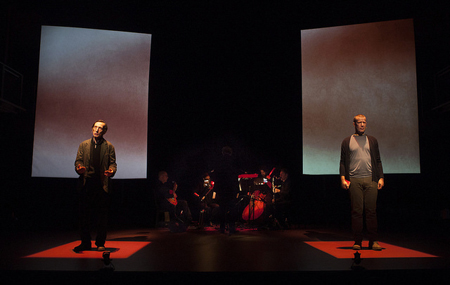
A study on the concept and theory of colour, I Send You this Cadmium Red is playing at Toronto’s Enwave Theatre
What do we talk about when we talk about color? Probably not the same things John Christie and John Berger did. The two men — one an artist, the other an art-writer — passed letters back and forth on the subject for more than two years, a beautiful correspondence that was later collected into the book I Send You This Cadmium Red. It’s a philosophical effort, but never fancy or arcane: just red, blue, and the rest. Beneath the simplicity, however, lies an astonishing depth.
First performed in 2011, Toronto’s Art of Time Ensemble takes up that remarkable exchange once again in a new production at the Harbourfront Centre this weekend. Set to a quavering and cinematic score by well-known British composer Gavin Bryars, the actors John Fitzgerald Jay and Julian Richings take turns reciting Christie’s and Berger’s letters. Jay plays Christie as a gentle contemplative, smart and a bit watery; Richings, on the other hand, makes Berger a terrific terror.
If you’re like me, John Berger’s name elicits a vague, warm feeling: Didn’t I read one of his books? Don’t I like him? Whatever sense you may have, whether poorly or properly formed, that Berger is a special genius whom you in particular admire, I Send You This Cadmium Red is the absolute proof.
Berger will say something like, “Red is innocent, the color of eyelids shut tight,” and then follow it with, “Red is the one color that is continually asking for a body.” He’ll say, “Charlie Parker became Bird because he knew about blue.” Poetry this alive is rare. It filled me with relief, in the way of honesty or beauty: forms of surrender.
Richings’s interpretation of Berger really crackles. There’s an old-man-in-the-lighthouse effect, like he’s spent too long alone being scoured by the Northern Lights. He burns darkly, with plenty of magic but without much softness. The portrayal suits Richings’s flinty, raw-boned appearance, but one wonders if Berger was really so wound up.
I didn’t come around to Christie as a character until I’d had a chance to reflect a bit after the show. Through most of the performance, I found him parasitic — his letters are full of quotations, collections of others’ phrases, petty by comparison to Berger’s thundering originality. It bothered me that Christie seemed to be winding Berger up, so as to extract his thoughts.
In fact, Christie’s intentionality provides a nuanced drama to the production. He’s clearly up to something, provoking Berger with little books of colors in the mail, to which Berger merely responds (albeit magnificently). By the end of the evening — and after more than twenty years of correspondence — we realize that Christie has all along been pursuing some fundamental understanding of color, through its most poetic valences, and he has wisely used Berger’s instincts to get there.
My companion for the evening pointed out that Christie’s contribution reveals something more essential about what it takes to reach those deeper levels of sensibility: slowness, stillness, care. At one point, he spends an entire afternoon watching a shaft of light travel across the room, and then he paints it onto the wall. (Sadly, I’d probably have stayed just long enough to find the right filter on Instagram.)
What is perhaps best about this whole conversation is that the sentimentality has been sifted out of it. These two men aren’t trying to add some extra sweetness to the world; the savoring they do is more direct. What else do you do with such a sensitive palette? You sample. You compare. You find the right words.
Details
- I Send You This Cadmium Red is playing April 9-12 at the Harbourfront Centre‘s Enwave Theatre (231 Queens Quay West).
- Shows run Thursday through Saturday at 8pm.
- Ticket range from $25-$59, and are available online.
(Image: Julian Richings, the Art of Time Ensemble, and John Fitzgerald Jay by John Lauener)
